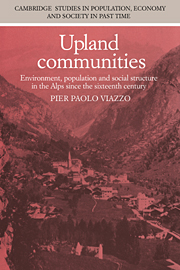 Upland Communities
Upland Communities Published online by Cambridge University Press: 13 October 2009
Anthropological models of the Alpine household
Over the last few decades, the emergence of common areas of research on the border between history and anthropology has led many anthropologists to acquire greater familiarity with the methods and techniques of historical demography. For their part, historical demographers are now paying more attention to the work of anthropologists, and the growing emphasis they are placing on nuptiality is likely to further increase their interest in a number of topics which have long been of primary significance in the anthropological investigation of social structure. As E. A. Wrigley has recently observed, if it is recognized that marriage was central to European population history, then ‘questions such as the transmission of property between successive generations, authority structures within the family, patterns of co-residence and support, the institution of service, inheritance customs, and cognate matters, can scarcely fail to attract study’.
Indeed, the results of our historical survey indicate that in order to shed more light on several important yet elusive aspects of Alpine demography it is necessary to examine in more detail what Jack Goody has called ‘the domestic domain’, and in particular the nexus linking inheritance systems to nuptiality and family formation. Both historians and anthropologists have widely assumed that impartible inheritance will produce low levels of nuptiality and a predominance of stemfamily households, whereas partibility should result in early marriage, moderate rates of permanent celibacy, and a high proportion of nuclear families.
To save this book to your Kindle, first ensure [email protected] is added to your Approved Personal Document E-mail List under your Personal Document Settings on the Manage Your Content and Devices page of your Amazon account. Then enter the ‘name’ part of your Kindle email address below. Find out more about saving to your Kindle.
Note you can select to save to either the @free.kindle.com or @kindle.com variations. ‘@free.kindle.com’ emails are free but can only be saved to your device when it is connected to wi-fi. ‘@kindle.com’ emails can be delivered even when you are not connected to wi-fi, but note that service fees apply.
Find out more about the Kindle Personal Document Service.
To save content items to your account, please confirm that you agree to abide by our usage policies. If this is the first time you use this feature, you will be asked to authorise Cambridge Core to connect with your account. Find out more about saving content to Dropbox.
To save content items to your account, please confirm that you agree to abide by our usage policies. If this is the first time you use this feature, you will be asked to authorise Cambridge Core to connect with your account. Find out more about saving content to Google Drive.